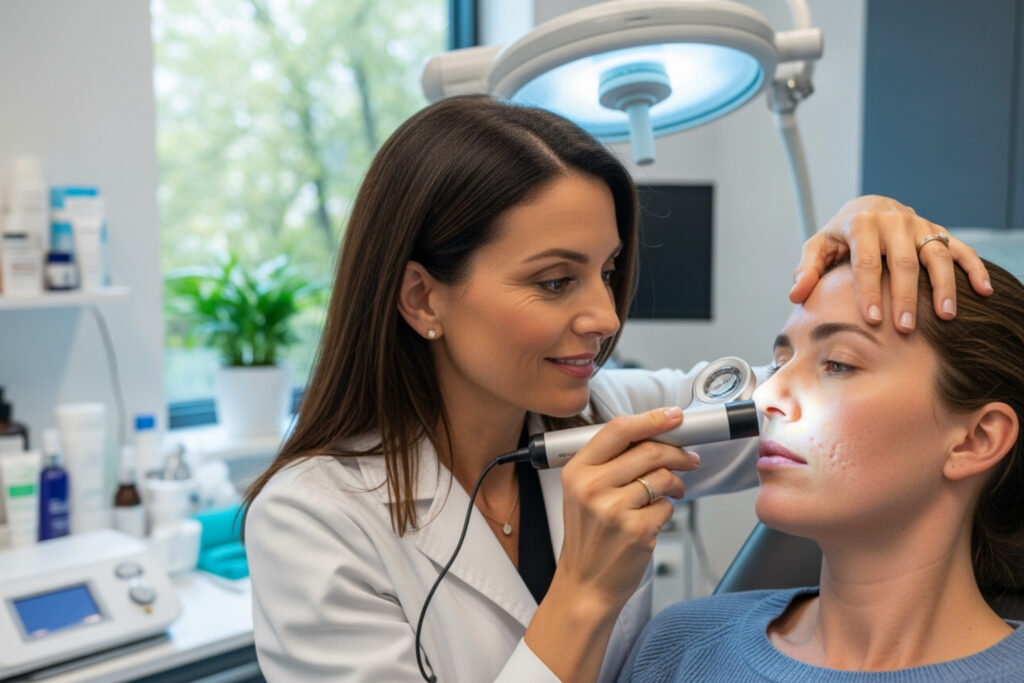Why Understanding Dermatologist Pore Shrinking Matters
Dermatologist pore shrinking is a top skincare topic. Many dermatology patients ask about visible pores, even when it’s not their primary concern. The truth is, while you can’t permanently shrink your pores (genetics determines their size), you can significantly minimize their appearance through proven methods.
Quick Answer: What Dermatologists Say About Pore Shrinking:
- Pores cannot be permanently shrunk – their size is genetically determined
- Appearance can be minimized through proper skincare and professional treatments
- Most effective approaches combine at-home care with dermatologist treatments
- Key ingredients include retinoids, salicylic acid, and glycolic acid
- Professional options include chemical peels, microneedling, and laser therapy
- Results require consistency – it’s about maintaining clear, supported pores
Your skin’s pores are tiny openings for hair follicles and oil glands that help regulate temperature and moisturize your skin. When they appear enlarged, they can create a rough, uneven texture.
The key is understanding what makes pores look bigger. It’s not just size, but what’s inside them and the structural support around them. Clogged pores stretch and appear larger. Similarly, when collagen and elastin break down from aging or sun damage, pores lose their tight appearance.
As one top dermatologist puts it: “I think of a pore as a column exiting at the skin’s surface. It can look bigger if there’s something within the column enlarging it, and it can also look bigger because of a weakening of the surrounding collagen. Healthy collagen sort of cinches a pore tight.”
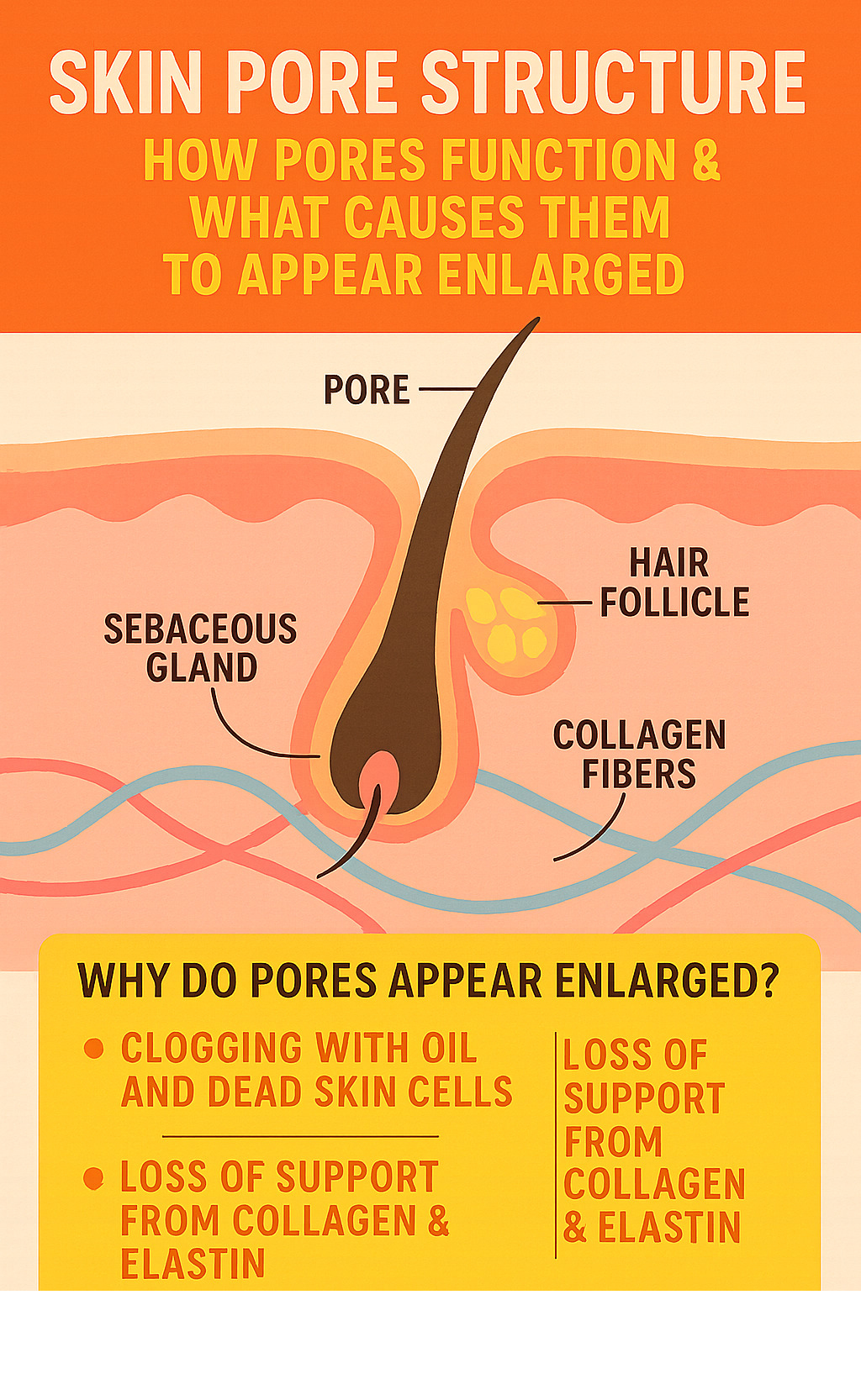
Dermatologist pore shrinking basics:
Why Do My Pores Look So Big? A Dermatologist Explains
If you’ve ever wondered “Why do my pores look so big?” you’re not alone. It’s one of the most common questions dermatologists hear, and the answer is multi-faceted.
The biggest factor in your pore size is genetics. You can thank your parents for this, as your baseline pore size is written in your DNA. However, genetics is just the starting point.
Other factors can make your pores appear much larger. Sebum production plays a huge role. When your sebaceous glands go into overdrive due to hormonal changes, your pores stretch to accommodate the extra oil.
This is why your T-zone – the forehead, nose, and chin area – tends to have the most visible pores. It has more oil glands, so more action happens there. Puberty is often when people first notice their pores becoming more prominent, as hormonal shifts ramp up oil production.
Aging adds another layer to the story. As we get older, our skin naturally loses collagen and elastin – your skin’s internal scaffolding. When this support system weakens, pores lose their tight appearance and start to look wider.
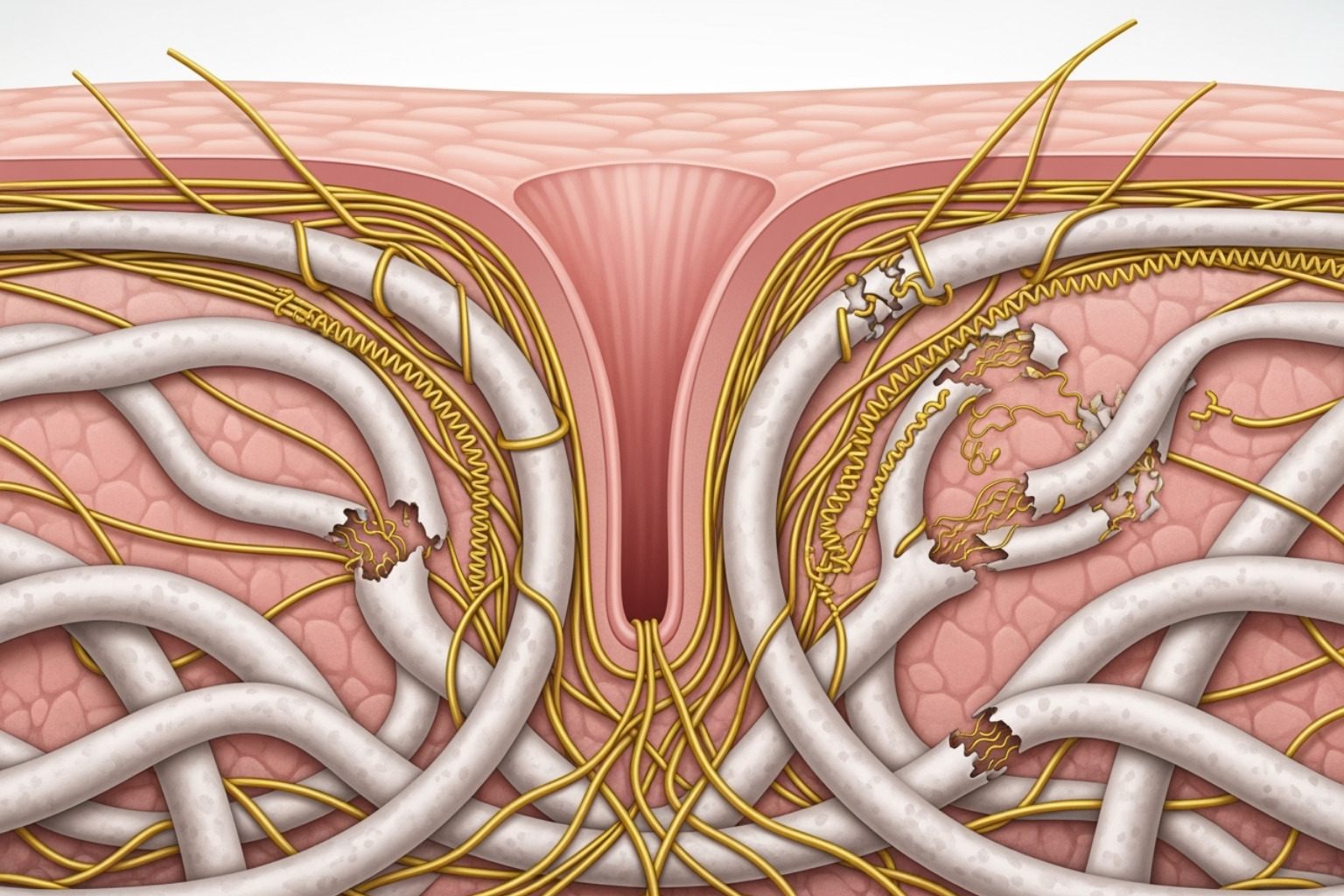
The Unseen Culprits: Oil, Debris, and Sun Damage
Beyond genetics and aging, other culprits make pores look larger. Research shows that excessive sebum, decreased elasticity, and increased hair follicle volume are the main players in enlarged-looking pores.
When pores get clogged, they stretch. Dead skin cells mix with oil and environmental debris, creating a blockage. Whether this turns into blackheads or acne lesions, the result is the same: your pore walls get stretched out.
Picking or squeezing makes everything worse. When you try to extract a blackhead yourself, you can traumatize the pore and potentially stretch it permanently. After an acne lesion clears, the pore can remain stretched from the inflammation.
Sun damage is another major pore enemy. UV rays don’t just cause wrinkles; they break down the collagen and elastin that keep your pores looking tight. When this structural support weakens, pores lose their firmness and appear larger.
This is why sun protection is crucial for maintaining pore appearance. A good broad-spectrum sunscreen preserves the structural integrity around your pores. Check out our guide on the Best Sunscreens for Oily and Acne-Prone Skin for recommendations that won’t clog your pores.
The Myth vs. Reality of Shrinking Pores
Here’s the truth about dermatologist pore shrinking: you cannot permanently shrink your pores. Your pore size is genetically determined, and no treatment will change their actual size.
The good news: you can absolutely minimize their appearance. What makes a pore look big is often what’s inside it or the lack of structural support around it.
The goal of any pore treatment is to make pores less noticeable by keeping them clear and supporting the surrounding skin. Many products promising to “shrink” pores are actually just providing temporary tightening or deep cleaning that makes them appear smaller for a while.
Setting realistic expectations is key. The aim is to refine your skin texture and create a smoother complexion, not perform miracles. Even advanced dermatological treatments focus on minimizing appearance rather than permanent shrinking.
The most effective approach combines keeping pores clear, controlling excess oil, and rebuilding collagen and elastin support. For targeted advice, our article on How to Reduce Large Pores on Nose offers practical solutions.
At-Home Strategies to Minimize Pores
The foundation of effective dermatologist pore shrinking starts at home. Your daily skincare routine is essential for maintaining and building upon the results of professional treatments.
Consistency is key. A daily routine supports your skin’s health and keeps pores looking their best. It’s about using the right tools, not complicated or expensive routines.
Cleansing is the cornerstone of pore care. Cleansing twice daily removes the daily buildup of oil, pollutants, makeup, and dead skin cells that settle into pores. When these materials accumulate, they stretch the pore walls. Use lukewarm water and a gentle, non-comedogenic cleanser; hot water can irritate your skin and trigger more oil production.
Exfoliation is where the magic happens. By removing dead skin cells that clog pores, regular exfoliation (1-2 times per week) keeps pores clear and your skin texture smooth.
Moisturizing is crucial, even for oily skin. When skin is dry, it often produces more oil to compensate. A lightweight, non-comedogenic moisturizer helps maintain your skin’s barrier and regulate oil production.
Sun protection is vital because UV damage is a major culprit behind enlarged-looking pores. Daily sunscreen with at least SPF 30 protects the collagen and elastin that keep pores looking tight. Without it, sun exposure gradually weakens the structural support around your pores.
The key is choosing non-comedogenic products for your entire routine, meaning they won’t clog pores. This applies to everything from your cleanser to your makeup. For a complete approach, check out our Skincare Routine for Oily Skin with Large Pores.
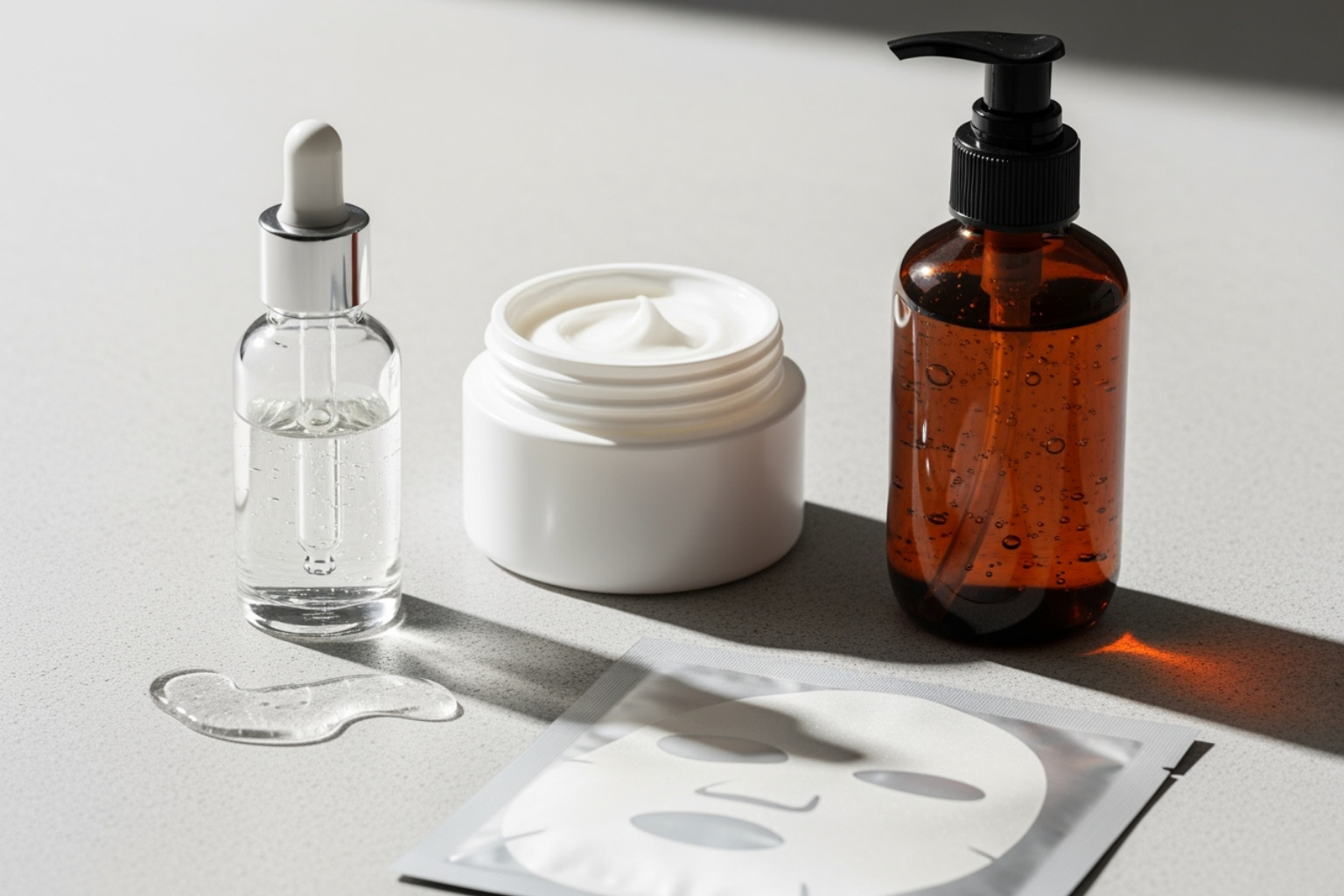
Key Ingredients to Look For
When scanning ingredient lists, look for powerhouse components that are dermatologist favorites for pore refinement. These scientifically proven ingredients address the root causes of enlarged-looking pores.
Salicylic acid (BHA) is the MVP of pore care. As an oil-soluble acid, it can dive deep into pores to dissolve the sebum and dead skin cells that cause clogging.
Glycolic acid (AHA) works on the skin’s surface, dissolving the bonds between dead skin cells to encourage shedding. The result is smoother skin texture that makes pores appear less noticeable.
Retinoids are the gold standard. Whether over-the-counter retinol or prescription tretinoin, these vitamin A derivatives speed up cell turnover to keep pores clear and stimulate collagen production for structural support.
Niacinamide is a gentle multitasker that helps regulate oil production, reduces inflammation, and strengthens your skin barrier.
Clay masks offer immediate gratification by drawing out impurities and temporarily tightening the skin. Bentonite and kaolin clays are effective at absorbing excess oil.
Witch hazel provides a natural astringent effect, temporarily contracting tissue to make pores appear smaller.
For help incorporating these ingredients, our Best Skincare Routine for Blackheads and Oily Skin provides targeted guidance.
Common Mistakes to Avoid at Home
Even with good intentions, it’s easy to make mistakes that can worsen the appearance of pores or cause skin damage.
Over-exfoliating is a frequent error. More isn’t better; it leads to irritated, inflamed skin that often produces more oil. Similarly, harsh scrubs can create microscopic tears in your skin, leading to inflammation.
The urge to squeeze or pick at pores is strong, but this action can permanently damage the pore structure, stretch the opening, and even lead to scarring.
Using heavy, occlusive moisturizers can backfire. Thick creams can trap oil and dead skin cells, leading to more clogging. Our guide to Lightweight Moisturizer for Oily Acne-Prone Skin offers excellent alternatives.
Skipping sunscreen undermines all your other efforts. Daily sun exposure breaks down collagen and elastin, which directly contributes to enlarged-looking pores over time.
Finally, throw away your magnifying mirrors. They create an unhealthy obsession with perceived flaws, making normal pores look enormous and leading to over-treatment and anxiety. No one views your skin under a magnifying glass.
Professional Dermatologist Pore Shrinking Treatments
When at-home routines aren’t enough, professional treatments can lift your results. Dermatologist pore shrinking treatments work differently than at-home products; they’re designed to create structural changes in your skin that make pores appear smaller over time.
The magic is in collagen stimulation and skin resurfacing. As collagen and elastin weaken, pores can sag and look larger. Professional treatments help rebuild this support structure from the inside out.
These treatments are effective because they create controlled micro-injuries, triggering the body’s natural healing response. Your skin repairs itself, often coming back stronger and tighter. A qualified dermatologist will create a personalized treatment plan based on your skin type and goals.
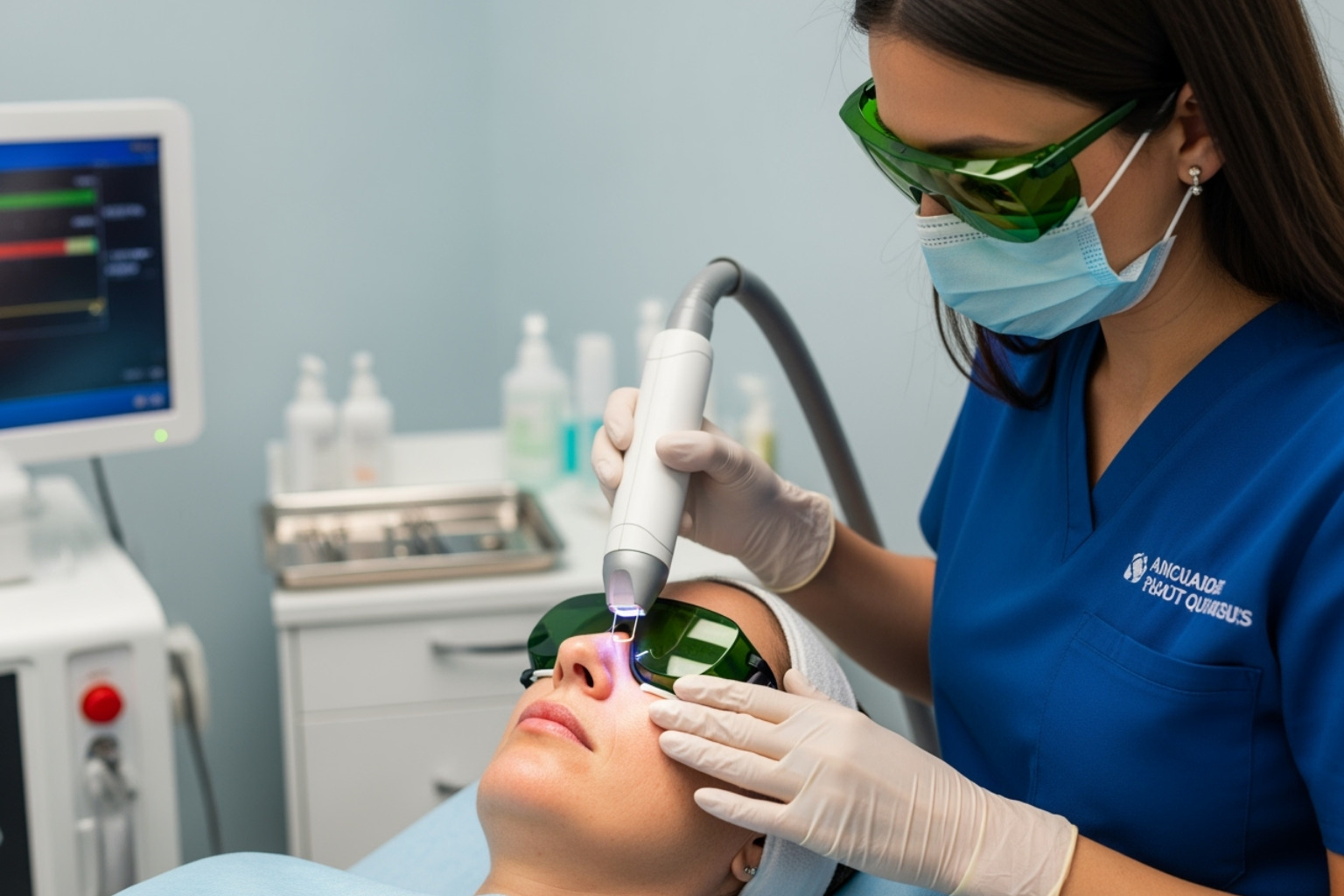
How Chemical Peels and Exfoliation Work
Chemical peels are a professional reset for your skin. Unlike gentle at-home acids, professional peels work deeper and faster to remove the outer skin layer and unclog pores more effectively than over-the-counter products.
Superficial peels are the workhorses for pore concerns. Glycolic acid peels cut through the bonds holding dead skin cells together, making skin texture smoother. Salicylic acid peels are oil-busters, diving deep into pores to dissolve the buildup of sebum and dead skin cells.
Microdermabrasion is like a professional-grade buffer for your face, gently sanding away the top layer of dead skin that can make pores look prominent. You’ll often see an immediate glow.
These treatments can be helpful if you’re dealing with stubborn clogged pores. For natural approaches to complement them, our Natural Face Treatment for Pimples guide offers additional insights.
The Role of Lasers and Light Therapy
Fractional lasers are a powerful tool for rebuilding your skin’s foundation. These treatments create thousands of microscopic treatment zones, leaving the surrounding tissue intact. Your body rushes to heal these zones by producing fresh collagen and elastin. As this new support builds, it tightens the skin around your pores, making them appear smaller. Laser therapy treatments have become a gold standard for this type of skin remodeling.
Intense Pulsed Light (IPL) works differently, using broad-spectrum light to heat the deeper layers of your skin, which kickstarts collagen production. You’ll often notice other benefits too, like reduced redness and more even skin tone.
While red light therapy is popular, research hasn’t proven it effective specifically for reducing pore size, though it may offer other skin benefits.
What to Expect from a Dermatologist Pore Shrinking Consultation with Microneedling
During a consultation, your dermatologist will examine your skin and develop a strategy. Collagen induction therapy (microneedling) is particularly effective for pores because it addresses the root cause: lack of structural support.
During the treatment, tiny needles create controlled micro-punctures that trigger your skin’s healing process. Your body responds by producing new collagen and elastin, which gradually improves skin firmness and makes pores appear tighter.
Radiofrequency microneedling takes this further. The needles deliver radiofrequency energy deep into your skin, creating heat that stimulates even more collagen production, leading to more dramatic skin tightening results.
Dermatologists use longer needles (1.5 to 2 mm) than at-home devices (<0.5 mm), allowing them to reach deeper layers where collagen production happens. Topical numbing cream makes the process comfortable.
Expect some redness for a day or two afterward. Most people need a series of treatments for optimal results, since collagen production is a gradual process. For more targeted advice, check out our guide on How to Tighten Pores on Cheeks.
Frequently Asked Questions about Pore Treatments
When it comes to dermatologist pore shrinking, many questions arise about what truly works. Here are the most common questions, answered with the truth about what’s possible for your pores.
Can you permanently get rid of large pores?
Here’s the reality: you cannot permanently get rid of large pores. Your pore size is written in your genetic code. These tiny openings in your skin aren’t flaws to be eliminated; they’re essential pathways that allow your skin to breathe, release sweat, and maintain its natural oil balance.
However, you can dramatically minimize how they appear. A clean, well-supported pore looks completely different from one that’s stretched with debris or surrounded by sagging skin.
Collagen support is absolutely key. Treatments that boost collagen – like retinoids, microneedling, and certain lasers – are effective for improving pore appearance.
Consistency is crucial for maintaining results. Your skin is constantly changing. Even advanced laser treatments that offer long-term reduction in pore visibility require maintenance over time.
Does drinking water help shrink pores?
Water is wonderful for your overall skin health. When your skin is properly hydrated, it looks plumper and healthier, which can make pores less noticeable.
Hydration supports overall skin health in ways that indirectly benefit pore appearance. Well-hydrated skin functions better, which can help regulate oil production.
However, drinking water does not directly shrink the pore structure itself. Pores have a fixed genetic size. While dehydration can worsen the appearance of pores, drinking more water won’t transform your pore size. Think of it as one important piece of the puzzle, not a magic bullet for dermatologist pore shrinking.
What is the most effective treatment for enlarged pores?
The “most effective” treatment depends on why your pores look enlarged. A strategic, combination approach works best for most people.
For oil-related pore concerns (stretched from sebum and debris), retinoids are considered the gold standard. They increase cell turnover to keep pores clear and stimulate collagen. Prescription tretinoin offers more dramatic results than over-the-counter retinol. Salicylic acid is another powerhouse for dissolving buildup.
For aging-related pore concerns (collagen loss makes pores look slack), fractional lasers offer some of the most impressive results. These treatments build fresh collagen and elastin, resulting in tighter, firmer skin that makes pores appear smaller. Microneedling, especially with radiofrequency, works similarly.
Most people benefit from addressing both oil control and collagen support. That’s why we always recommend consulting a dermatologist for a personalized plan. They can assess the cause and create a treatment strategy that makes sense for your skin.
Conclusion: Your Path to Smoother Skin
We’ve covered why pores look bigger and which powerhouse ingredients make a difference, giving you the knowledge to tackle pore concerns with confidence.
Remember: pore appearance can absolutely be managed, even though we can’t permanently shrink them. It’s not about achieving the impossible, but about working with your skin to make it look its absolute best.
Consistency is your secret weapon. Daily habits like gentle cleansing, faithful sunscreen application, and using proven ingredients like retinoids and salicylic acid are the foundation of real change.
When you’re ready, professional dermatologist pore shrinking treatments can be game-changers. Chemical peels, microneedling, and fractional lasers can deliver dramatic improvements that at-home care alone might not achieve.
At Beyond Beauty Lab, we believe knowledge is your most powerful beauty tool. Understanding your skin empowers you to make smart choices rather than falling for quick fixes.
Your skin’s journey is a process, not a destination. The key is staying consistent and being patient.
Ready to put this knowledge into action? Explore our recommended skincare products to find the right tools for your needs. For those with oily, acne-prone skin, our comprehensive Best Skincare Routine for Oily Acne-Prone Skin guide is packed with proven strategies.
Smoother skin isn’t about perfection – it’s about progress. With the right approach, that progress is within your reach.

